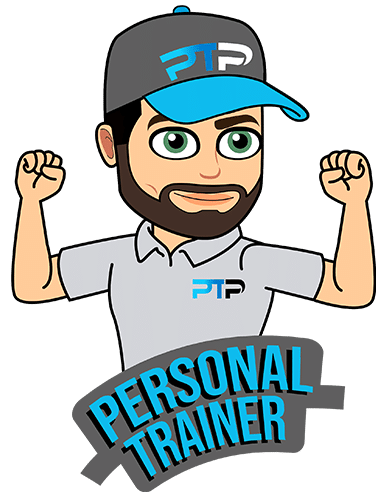In this article, I will be breaking down exactly what a career in personal training entails in 2025. You will learn:
Thanks to my 10+ years of experience in the industry, I can competently teach you everything that you need to know about a PT career.
Let’s get on with it!

What is a personal trainer?

Here, I am going to define what personal training is, who fits the bill, and what the profession requires of you.
Read on to find out more.
Before we get started, I have three important things to tell you:
- I have free study guides and practice tests for all of the top PT certifications.
- Trainer Academy has fantastic PT cert study materials and they offer an exam pass guarantee.
Make sure to take the quiz to get a good idea of which personal trainer certification is right for you.
I’d like to think you already know the answer to this question, but, for the sake of clarity, I’ll give you my standard definition of what I think a personal trainer is.
A personal trainer is a fitness professional who helps people to lead healthier, more active lives.
Of course, that covers a multitude of responsibilities and duties, from writing training programs to teaching correct exercise technique to carrying out fitness and health tests to offering nutritional advice.
It’s fair to say that, in this varied and exciting job, no two days are the same!
However, the primary role of a PT is to help people achieve their fitness and health goals.
As those goals can vary enormously from person to person, the skills you use from one day to the next can differ enormously too.
For example, one day, you might be pushing an elite athlete to their physical and mental limits, and the next day find yourself helping a complete novice learn how to operate a treadmill.
That’s the beauty of this job – there is so much variety!
Personal training – a (very) brief history

Did you know that personal training has been an officially recognized profession since as far back as 776 B.C?
In this section, I will take you on a ride into history to reveal how this profession came into being.
Let’s go back in time, shall we?
Because of increased media awareness, personal training often seems like a new avenue of employment.
But, the truth is, it’s been around for almost as long as humans have exercised.
The first documented trainers were plying their trade way back in 776 B.C. as they worked to prepare athletes for the ancient Greek Olympic Games.
On the other side of the world, Indian trainers called yogis worked one to one with their students to teach the art of yoga.
In the far east, martial arts masters worked one on one to impart the secrets of unarmed combat, and that training often involved strenuous exercise.
Romans, Greeks, and various other warring nations employed trainers to make sure their armed forces were fit to fight.
Some of those trainers also worked with high-ranking officials, usually combining fitness with sword, wrestling, and gymnastic training.
Fast forward a few centuries and crowned heads of state employed personal trainers.
One of the most famous was Eugene Sandow, a legendary theatrical strongman and bodybuilder whose likeness still adorns the Mr. Olympia bodybuilding winner’s trophy.
Sandow trained many famous and wealthy British people during the Victorian era, not least Prince Albert – Queen Victoria’s husband.
Personal training really took off with the advent and popularity of TV.
American Jack LaLanne, often called the father of modern fitness, was an immensely popular trainer and fitness personality who worked with many Hollywood stars.
Another popular trainer of the time, Vince Gironda, trained the likes of Clint Eastwood, Cher, and even Bruce Lee, as well as top bodybuilders.
Personal training really came to the fore when stars like Madonna, Sylvester Stallone, and Tom Cruise credited their trainers for getting them into shape for movie roles.
Suddenly, personal trainers were as famous as their celebrity clients, and PT became a popular job choice.
Nowadays, it’s not just the Hollywood elite who work with trainers; the average exerciser can too.
Personal training is no longer a fringe career choice but is well and truly mainstream, and as the industry grows, more and more PTs will be needed.
This is an excellent time to be a personal trainer!
Personal training duties & responsibilities – A day in the life

What exactly does a personal trainer do on a daily basis?
Come with me, let me reveal what the life of a personal trainer looks like from sunrise to sunset.
I’m sure you’ll love it.
Let’s do this.
If you have ever had a personal trainer or watched one in action at your gym, you may think you already know what the job entails.
And while you may have a pretty good idea of what PTs do from one day to the next, you may be surprised to discover all the duties and responsibilities personal training involves.
To give you a better understanding of a day in the life of a personal trainer, these are the things that most trainers do daily.
You might do each of these things every day, but they’ll certainly take up most of your time.
1. Initial consultation
Personal training, as the job title suggests, means providing a personalized service designed specifically for the individual client.
The law of exercise specificity dictates that you are fit for the type of exercise you do.
Therefore, if you want to achieve certain goals, you need to train a certain way.
Before they design a program, personal trainers must spend time getting to know their clients and assessing their needs and wants.
In most cases, this will also involve a health and medical screening to make sure the client is well enough to exercise.
After that, you’ll gather information regarding your clients’ goals – why are they exercising, and what do they want to achieve?
You may also have to conduct some fitness tests, which will make it easier to design the ideal program; not too hard but not too easy either.
Knowing your clients’ levels of fitness and strength will also give you benchmarks to measure their progress.
You may also measure their flexibility and even assess their posture.
Armed with this mountain of information, as well as the clients’ exercise likes and dislikes, time available, any other relevant details, you can then start creating a workout program.
Trainers who don’t gather all this information are just guessing when it comes to program design, and that’s a very unprofessional approach that we definitely do not recommend.
And speaking of program design…
2. Program design
Program design is both a skill and an art, and there is a right and a wrong way to do it.
The programs you write should match your clients’ needs and abilities.
Your workouts should be challenging enough to trigger the adaptations the client wants, but not so hard that they are too exhausted to do it all again in a couple of days’ time.
New personal trainers often take a long time to write programs, as they second guess each exercise, set, and rep they plan.
But, the good news is that designing workouts gets easier the more you do it, and you’ll soon find yourself creating programs in minutes and not hours.
Depending on your clients’ needs, your program will include:
- Warm-up
- Main session – strength training
- Main session – cardio training
- Core work
- Cool-down
Some trainers use a pen and paper to write their workouts while others use program design software and apps.
Both approaches work, so it’s up to you which one you use.
3. Delivering workouts
Armed with your program and with your client by your side, it’s time to deliver the workout you have designed.
Depending on your client’s level of experience, this may involve demonstrating some or even all of the exercises in the workout.
Even if the client knows how to do the prescribed exercises, you’ll still need to monitor them closely, offering encouragement and feedback the whole time.
A lot of clients need to be encouraged to exercise, while others need to be reined in to stop them overexerting themselves.
Good personal trainers are experts at reading people and know when to push and when to back off.
And, coaching and encouraging your client, you also need to remember to count how many reps they’ve done!
For the next hour or so, your sole responsibility is to ensure your client has a safe, enjoyable, and productive workout.
At the end of the session, your client should be one step closer to reaching their fitness goals, and you should have exceeded their expectations so that they want to come back and work with you again, and again, and again!
4. Fine-tuning and progression
Even if you wrote the perfect program, you might find you need to make adjustments as you deliver it.
This is perfectly normal and something you need to be prepared for.
Let’s say you prescribed squats but, despite your demonstration and best coaching efforts, your client is unable to do them properly or safely.
Without fuss or delay, you’ll need to come up with an alternative exercise that you can slot into the workout and use instead.
Because of this, you must have a library of different exercises to call on.
Remember, there is no such thing as a best exercise, and there is more than one way to skin the proverbial cat!
Also, remember that today’s new program won’t be as effective tomorrow.
Your client will adapt to your workout, and you’ll need to progress it to ensure they keep getting fitter and stronger.
The workout you spent so long writing is just the first step on the ladder, and you need to know where it’s going next.
As you deliver your workout, you should be thinking about how you are going to adjust it so that it’s just a little bit harder next time.
5. Progress checks and reassessments
After a few weeks with your client, you should start to see some changes in either their performance, appearance, or both.
They may even be closing in on their original health and fitness goals.
Periodic progress checks and reassessments will provide you with the information you need to create your next set of programs.
It will also be a source of motivation for your client.
And so, the cycle begins again!
6. Nutritional and lifestyle advice
What your client does outside of the gym is every bit as important as what they do with you in it.
Even the best program won’t produce results if your client doesn’t eat healthily or has an unhealthy lifestyle.
Because of this, a trainer can also expect to give advice on the following topics:
- Diet
- Meal timings
- Hydration
- Supplements
- Sleep
- Smoking and alcohol
- Stress
- Time management
- Motivation
- Willpower
Personal training involves a lot more than just taking clients around the gym, but if you get it right, you can have a HUGE impact on your clients’ entire life and wellbeing.
7. Promotion and marketing
Of course, you won’t be able to do any of these things if you don’t have any clients, and that’s where promotion and marketing come in.
The type and amount of promotion and marketing you need to do depend on where you work and whether you are employed or self-employed.
Employed personal trainers work for gyms and are allocated clients by the facility manager.
They receive a fixed salary and have set working hours.
In contrast, self-employed or freelance personal trainers are responsible for running their own business.
They set their own schedule and essentially rent gym time/space for their clients.
Most personal trainers are self-employed.
Whatever your employment status is, you’ll want to be busy and have plenty of clients to work with.
Of course, before you can do any of the tasks outlined above, you need to get qualified, so let’s move onto that weighty topic!
Personal trainer requirements

This section is dedicated to the requirements you need to have before becoming a personal trainer.
Personal training certifications are fantastic – and important to get started in the fitness industry.
I’ll list the most important certifications below.
Ready? Let’s go.
In the not-so-good old days, you could call yourself a personal trainer even if you didn’t have any experience or qualifications.
I’m glad to say that the fitness industry is much more regulated now, and that means the standard of personal training has increased enormously.
Now, if you want to be a PT, you need to get a recognized certification.
The best personal training certification organizations include:
- International Personal Trainer Academy – IPTA
- International Sports Sciences Association – ISSA
- National Academy of Sports Medicine – NASM
- American College of Sports Medicine – ACSM
- American Council on Exercise – ACE
- National Strength and Conditioning Association – NSCA
All of these providers are all widely recognized, and having a certificate from any one of them should mean you are appropriately qualified to work in the fitness industry.
Course costs and length vary from provider to provider, as does course format.
However, they all involve theory and practical instruction and assessment, course work, and are designed to prepare you for working with a range of clients.
To enroll in any personal training course, you will need to be 18 or older and hold a high school diploma.
Some advanced PT courses may require a college degree before you can enroll.
Check with the provider you are thinking of enrolling with to make sure you meet their enrolment criteria.
Before starting work in a gym as a personal trainer, you’ll also need to have a CPR/AED and a first aid qualification.
While accidents and emergency situations and thankfully rare in gyms, personal trainers still need to be prepared for the worst.
A CPR/AED and first aid certification mean that if something untoward should happen, such as your client has a stroke or heart attack, you will be able to give cardiopulmonary resuscitation (CPR), use an automated external defibrillator (AED) or provide the necessary treatment to persevere life and prevent the condition worsening.
Holding a CPR/AED/First Aid certificate is a typical prerequisite for getting insurance.
Speaking of insurance, all PTs should make sure they have health, liability, and medical insurance so that they are legally and financially protected.
Buying insurance can be expensive but getting sued is usually much more so!
You won’t be able to get insurance unless you are certified.
If you work for a gym, your employer may take care of your insurance but, if you are self-employed, that particular buck stops with you.
What are the benefits of being a personal trainer?

Haha! Benefits!
I’m sure you have been wondering what’s in it for you.
I’ll go through all the amazing benefits and advantages you stand to gain if you eventually take up this profession.
Welcome to my world!
Are you still on the fence about becoming a personal trainer?
That’s ok; it’s a big career decision to make!
And while I’m definitely biased, I think being a PT is one of the most rewarding jobs around.
To help you make up your mind about whether a career in personal training is right for you, in this section, I’m going to discuss what I think are the main benefits of being a PT.
1. You can turn your hobby into a career
Do you love to work out?
Is it one of your life’s passions?
If so, you could be very suited to life as a professional personal trainer.
Being a PT means you get to eat, sleep, and breathe exercise.
If you are a dyed-in-the-wool exerciser who loves thinking, reading, and talking about health and fitness, why not turn your hobby into a well-paid career?
One of the great things about doing something you love is that you look forward to going to work.
In fact, there are days when going to work doesn’t feel like a job at all!
2. Work with like-minded people
One of the things I quickly discovered when I started my PT career is that most trainers have the same passion for fitness and exercise.
Watching other trainers is an easy way to pick up training tips, and almost every trainer I’ve ever met is more than happy to swap workout and nutrition ideas with other PTs.
I don’t think I’ve ever worked in a more friendly, giving environment.
3. Very personally rewarding
As a personal trainer, your main job is helping people reach their health and fitness goals.
This could be anything, from training for a 5k race to losing weight for a wedding to preventing falls in older people.
You have the opportunity to have a life-changing impact on your clients!
This is hugely rewarding.
I have helped my clients recover after serious injuries, win medals, get healthy enough to stop taking medication, and even find love!
Of course, some clients really do just want you to write workouts and push them to train harder, and that’s just fine too.
But, on other occasions, your impact will be much bigger.
4. Constant learning
Getting qualified is your first step on the ladder of personal training, but you are a very long way from the top!
This is a job that is continually evolving, and a good trainer should work hard to keep pace with the ever-changing fitness industry.
If you have a thirst for fitness and nutrition knowledge and love learning more about your specialist subject, this is the job for you.
As well as scouring the internet for up to the minute training and diet information, you can also enroll in specialist courses to keep your knowledge up to date.
You can also take your personal training career in a very specific, specialized direction – such as pre/post-natal, working with seniors, injury rehab, or sports training and conditioning.
With almost unlimited learning opportunities, there is no need for your personal training career to stall or become dull.
There are always new avenues to explore.
5. Set your own schedule
Unless you are employed by a gym, you will be able to set your own work schedule.
This is incredibly liberating if you hate the usual nine to five routine.
For example, I like to start work early in the morning and then take an extended afternoon break before heading back to work for a few hours in the early evening.
This gives me time to pursue my hobbies and pastimes, which were things I could only do at weekends in my previous job.
Being a self-employed PT also means you can take time off when you want to.
Just let your clients know you won’t be around for a while, set them up with programs to do in your absence, and check-in with them via video call, phone, or text to keep them on the straight and narrow.
6. Access to state-of-the-art training facilities – usually for free!
If you love to work out, personal training could be the ideal job for you.
After all, if you want to train, you are already at the gym, so there is no need to commute.
A lot of trainers like to work out before their first or after their last client of the day.
You can also train between clients if you have a gap in your diary.
Training where you work is also an excellent way to promote your business.
With unlimited access to a gym, you should have no problem talking the talk and walking the walk.
Good trainers practice what they preach!
7. A portable career
If you get a widely recognized personal training qualification, you can work almost anywhere in the world.
Why not combine your job with travel?
I have PT friends working in all four corners of the world, from Asia to Europe, to the Middle East.
Some are traveling and using their PT qualifications to pay their way, working for a few months in one place before moving on.
Others have moved, lock, stock, and barrel, to new parts of the world and taken up full-time residence.
The good news is that personal trainers are always in demand, and the language of fitness and health is truly international.
8. Financial independence and job security
I can’t talk about a career in personal training without talking about money and income.
Your hourly rate is dependent on your experience, the area in which you work, how affluent your clients are, the services you can provide, and a host of other factors.
But, that said, you should be able to command a higher-than-average hourly rate, which means personal training can be financially rewarding.
According to a study we commissioned, full-time personal trainers make between $42k – $72k per annum, with the average being $59k.
Part-time trainers make between $25k – $35k.
Top tier trainers can make $70-$100k per annum, and some earn even more than this.
Of course, we can’t guarantee you’ll hit these numbers but, if you work hard and do your best, they are very realistic.
But, what does the future hold for the fitness industry?
The good news is that it’s growing exponentially.
According to CNN Money, personal training is the 18thmost popular, sought after, and potentially lucrative career choice around.
Why is personal training, and the fitness industry in general, growing, despite many other businesses contracting or failing?
Good question!
There are several reasons that personal training is here to stay…
The obesity crisis– more and more people are overweight and need help to get back in shape.
With our knowledge of exercise and nutrition, personal trainers are uniquely positioned to help.
An aging population– people are living longer than ever, and most want to maximize their quality of life in their later years.
Many of these older exercisers value and recognize the need for professional guidance, and also have the time and financial means to work with a personal trainer.
Increased awareness– fitness is a media hot topic, and more and more people are coming to the conclusion that they need to exercise.
But most don’t know where to start.
Personal trainers are often quoted as sources in news reports, and the general public views us (quite rightly) as experts in the fitness field.
Subsequently, when a member of the public decides it’s time to get fit or lose weight, their first port of call will probably be a personal trainer.
Corporate health and fitness programs– more and more companies are coming to the conclusion that a healthy, fit workforce is a more productive workforce.
That’s good news for personal trainers.
Lots of companies have gyms that need PTs, offer subsidized gym memberships to their employees, or provide incentives to employees to get and stay in shape.
That means more work for personal trainers.
The rise of youth fitness– when I was a kid, we kept fit by playing games outside and through physical education classes in school; there was no real need for formalized exercise unless you played competitive sports.
With the increased emphasis on academic performance, fewer opportunities to play outside, an increase in passive entertainment, and junk food available in abundance, today’s kids are more likely to be unfit and overweight.
The government, schools, concerned parents, and even the kids themselves are taking steps to address and rectify these problems, and PTs are on the front line of making things happen.
With funding available and a high level of interest, PTs are ideally positioned to help deal with and benefit from the need for youth fitness.
New workout techniques– thanks to the media, the public is more informed about fitness and exercise than ever before.
I say informed but, what I really mean is they have probably heard about things like HIIT, CrossFit, functional fitness, TRX, and all those other media-friendly training techniques.
Because they’re seen them on TV or read about them, they want to try them!
Trainers need to keep up with the current fitness trends so that they can answer questions about and even deliver the latest workout methods.
I’d be lying if I said that trends don’t matter in fitness – they really do.
But, if you keep up to date with all the new (safe and effective) training methods, you should find that you are always busy.
And the good news is that, almost monthly, a new training technique comes to light so your professional knowledge should always be in demand.
9. Quality of life
I genuinely believe that personal trainers have a better quality of life than many other careers.
We love the job we do, enjoy flexible hours, have a secure career path, work in a healthy environment, and have access to a gym whenever we want one.
It’s hard to not feel happy about going to work.
I don’t see the point in earning millions of dollars if you are unhappy or unhealthy.
Personal training provides the means to make a good living without sucking the life out of you.
While every trainer has the occasional bad day at work, I’m betting those days are very few and far between, especially compared to many other forms of employment.
Are there any drawbacks to being a personal trainer?

Below, you’ll learn about the key drawbacks you may encounter along the way.
Don’t worry; they are all surmountable – you just need to put in the work.
Let’s see what those possible challenges are, shall we?
I’d love to be able to tell you that personal training is all unicorns and rainbows, and you will be a millionaire in five years or less.
But if I did, I’d be lying.
So, to provide you with a fair and honest view of working in the fitness industry, here are the main drawbacks you should consider before starting your career.
1. Getting qualified
Signing up to a personal training course does not automatically mean you’ll pass.
You are going to have to study and apply yourself to gain your qualification.
The provider will do everything they can to support you on your learning journey, but you are still going to have to commit to the process and work hard.
You’ll also need to pass several different assessments, both practical and written.
While most candidates are successful, a small number are not.
Think about these things before you enroll in a personal training certification course.
2. Financial responsibilities
If you are self-employed, you are your own boss.
In many ways, that is truly liberating, but it comes with several financial responsibilities.
As the boss, it’ll be up to you:
- Pay your gym rent/commission
- Pay your professional liability insurance
- Pay any professional memberships
- Buy your workout clothes
- Pay your health insurance
- Buy additional equipment
- Pay for marketing
Also, because you are reliant on your clients for your salary, if you have a quiet week, you could find yourself short of funds when the monthly bills start to arrive.
While your earning potential is high, there are no guarantees, and there is a chance you could be financially unsuccessful.
All these financial responsibilities rest squarely on your shoulders.
3. It can take time to become successful
Certified?
Insured?
Ready to go?
Don’t be surprised that, for the first few weeks of being a personal trainer, you don’t have very many clients.
It takes time to develop a big client base so that you are busy enough to make adequate money to get by.
Because of this, a lot of PTs start out part-time, so they have an extra income they can rely on until their personal training business takes off.
If you want an instant business or are looking for a get rich quick scheme, personal training ain’t it!
4. If you don’t work, you probably won’t get paid
One of the best things about working as a PT is also one of the biggest drawbacks – a flexible work schedule.
While you are your own boss and have control over your diary and bookings, if you decide to take time off, you won’t get paid.
That’s fine if you are well ahead and have money in the bank, but if you are sailing close to the wind, taking time off could be ruinous.
Want a vacation?
Need time off because you are sick?
Got to take your dog to the vet or get your car serviced?
Expect to pay double for anything that takes you away from work – once for whatever you are buying and again for your loss of earnings.
5. Competition
Guess what; you are not the only person reading this article.
Right now, hundreds if not thousands of people just like you are thinking about starting a career in personal training.
It’s also estimated that there are 340,000 PTs working in the US today.
Every prospective and current personal trainer is a potential competitor, and they want to be successful just as much as you do.
This means, to make money, you’ll need to go toe to toe with other personal trainers to win and keep new clients.
Your chances of success are higher if you are professional, take your marketing seriously, pitch your prices at the right level, and otherwise do a good job.
But, even then, you may find that there simply isn’t room for you at the gym you want to work at.
The good news is that gyms always need trainers, and you could always look into opening your own personal training studio.
However, competition is real, and if you aren’t prepared or feel unable to compete, you may struggle to build your personal training business.
6. Limited professional support
Having a bad day at work?
Car broke down, and you are running late?
Difficult client?
As your own boss, it’s up to you to deal with these and any other issues that crop up during the day.
There is no HR department, no one to step in and take over if you are late or ill, and no complaints manager to shield you from any unhappy customers.
It’s all you!
Being your own boss is liberating, but you’ll also have to accept the bad with the good.
If you aren’t prepared to take the rough with the smooth or prefer to delegate than take a hands-approach to work, maybe this isn’t the job for you.
7. You may have to sacrifice your own workouts
Being a successful personal trainer may mean you spend all day in a gym that you don’t have time to use yourself.
I’ve had days where I’ve had back to back clients for ten hours straight and then, when it came time for me to work out, I’ve gone home instead.
While I believe that all trainers should work out themselves, I also understand it’s not always easy – especially when you are busy.
Busy trainers should look for time-efficient ways to work out so they can stay in shape even when time is against them.
You wouldn’t accept a client telling you that they are too busy to exercise, so don’t use that excuse yourself!
And remember, a short but sweet workout is always preferable to not working out at all.
Every little helps.
Despite listing almost as many drawbacks as benefits, I still think personal training is one of the best jobs on the planet.
I’ve been in the fitness industry for a L-O-N-G time, and I don’t regret a single day.
But, when making any life-changing decision, it’s crucial to have all the facts so you can make an informed choice.
Of course, to enjoy all the benefits of a career in personal training, while avoiding as many of the drawbacks as possible, you need to go about things the right way.
In the next section, I’m going to reveal some of my top tips for becoming a successful personal trainer.
How to be a successful personal trainer

Since the main purpose of this article – and my whole website – is to make you a successful personal trainer, I’m going to spend some time in the section below to reveal a lot of my secrets
Don’t go anywhere just yet; we are just getting started!
Take your marketing seriously
It doesn’t matter how good you are at your job; if no one knows who or where you are, you could end up being the best unemployed personal trainer in town!
Because of this, you must take marketing seriously.
Here are a few marketing and promotional ideas to get you started:
- Build a website or a professional social media page for your business
- Brand your clothing
- Put up posters or hand out leaflets
- Offer opening day/week/month discounts
- Tell as many people as you can you about your services
- Offer free taster sessions
- Offer free workshops or lectures
- Ask any current clients for referrals
- Do seasonal promotions – 12 workouts for the price of ten at Christmas for example
- Advertise in any relevant local publications
- Do targeted social medial advertising
- Ask fellow trainers for referrals
Marketing can be time-consuming, and it may even be expensive, but it’ll be worth it.
Or, you could be one of those trainers who just stands around waiting for clients to come to them.
Guess what; in all my years of experience, I’ve never seen that approach work!
Create a financial safety net
Had a good week or month?
Great!
Don’t spend all your hard-earned money right away.
If you can, take some of your earnings and put it to one side, keeping it for emergencies.
That way, if you have a bad week, you will have enough money behind you to weather the storm.
Most PTs have business peaks and troughs.
When things are good, they’re very good, but when they’re bad, they’re terrible.
Enjoy the good times, but also plan for the bad so that your business doesn’t sink without a trace just because a few of your regular clients go on vacation at the same time.
Be the consummate professional
For the hour your client is with you, they are essentially your boss.
Behave like it.
Gyms are generally quite informal environments, but that doesn’t mean you should let your professional standards slip.
Your client might not say anything at the time, but if they think you are being unprofessional, they won’t book in with you again.
Recruiting clients is hard work, so don’t risk losing them because you say or do something that they don’t like.
Things to avoid include:
- Arriving late or finishing early
- Not paying attention
- Not changing the clients’ program regularly
- Gossiping about other trainers
- Breaking client-trainer confidentiality
- Unsolicited touching
- Off-color, racist, sexist, or homophobic jokes or comments
- Swearing
- Being judgmental
- Being untidy or unhygienic
- Dishonesty
- Making false claims or promises
You might only see your clients for an hour or two per week, but during that time, you can make or break your professional reputation.
Do things right, and they’ll tell your friends and recommend you to anyone they meet.
Do things wrong, and they’ll tell twice as many people.
Act like the consummate professional at all times, and you’ll never have to worry about your reputation.
Find your niche
Personal trainers all qualify with similar skill sets – trained and able to deal with middle-of-the-road clients.
How many of those clients do you think there are to go around?
Thin the competition by finding a niche.
A niche is something that you can or want to do that other trainers can’t or won’t.
For example, you could specialize in weight loss, bodybuilding, the elderly, youth fitness, training for sports, or training runners or triathletes – it’s up to you.
Having a niche cuts both ways; while it means less competition, it also means you have a smaller potential client pool.
But, because you’ll essentially “own” a larger percentage of a smaller number, you should still come out on top.
Separate your personal and professional social media
A social media presence is all-but essential for building a successful personal training business.
It provides an easy way to communicate with large numbers of potential, existing, and past clients.
You can also use your social media page as an ad hoc website, which is good news if you don’t want to pay to have one built.
But you should avoid combining your personal social media page with your professional page.
Why?
Because your friends may make comments or posts that aren’t relevant and are even offensive to your clients.
The last thing you need is your friends and casual acquaintances accidentally undermining your professional standing and reputation, so keep your work and personal pages separate.
Read, read, and read some more!
The fitness industry is continually evolving.
A good trainer must stay up to date with the most recent developments.
That way, when a client asks a question about the latest exercise or diet trend, you’ll have an informed answer.
The best trends will adhere to the underlying physiological principles that were drummed into you on your certification course, so you should be able to tell if a new training technique or diet is any good.
In some cases, knowing about the latest trend could save your client from wasting time, money, or energy.
Other times, you may learn something new and want to add it to your workout arsenal to keep your services current.
Either way, if you want to be successful, you need to understand that your PT certification was the springboard from which you’ll launch your entire fitness career.
A good personal trainer never stops learning.
Plan to expand
Personal trainers have two main ways to increase their income – do more hours or charge more per hour.
Option one has limited appeal, and option two is not always practical as your price per hour depends on what your clients are willing or able to pay.
There is a third option – expansion.
This means finding other ways to increase your income.
Options include:
- Start a personal training studio
- Sell clothing/supplements
- Subcontract trainers to work with you
- Offer paid nutritional consultations
- Offer sports massage
While some of these ideas will require additional investment or more training, they could significantly increase your income.
For example, if you set up a small personal training studio, you could sublet it to another trainer, and also hire space to a therapist.
This will generate an additional income while you continue training your own clients.
If you think you’ll be happy earning the same salary for the next few years, you don’t need to do any of these things.
But, if you want to earn more and potentially work less, start thinking about expansion.
You might not put your plans into action for a year or two, but the sooner you start planning, the readier you’ll be when the time arrives to do it.
Personal Trainer Career FAQ
Conclusion

You see, you too can begin and grow a personal training career.
You too can become very successful in no time.
I hope my tips and revealed secrets help you along the line.
Till next time, adios!
I have no hesitation in recommending a career in personal training.
It’s rewarding on so many levels – including financially and in terms of job satisfaction.
If you love fitness and enjoy helping people achieve their goals, this is the job for you.
Is it easy?
No.
But very few things in life that are worth having are.
Studying to become a PT can be hard work and will take time and effort.
Setting up your business will be equally challenging.
But, once you’ve put in the hard yards, you’ll be rewarded with a career that will provide you with financial security, lots of job satisfaction, and the means to work almost anywhere in the world.
It’s also a job that will develop and grow as you become more established in the industry.
In addition, the demand for personal trainers has never been higher, and good PTs can expect to be as busy as they want to be.
If you think personal training is the career for you, there is no better time to start than now.
Good luck!
References
- “Personal Trainer Software.” Capterra, https://www.capterra.com/personal-trainer-software/.
- WordPress.com, https://wordpress.com/.
- “Comparing Personal Trainer Certifications.” American College of Sports Medicine (ACSM), https://www.acsm.org/get-stay-certified/get-certified/comparing-personal-trainer-certifications.
- “Insurance for NASM-Certified Professionals and Associates.” National Academy of Sports Medicine (NASM), https://www.nasm.org/resources/insurance.
- “Training.” First Aid USA, http://www.firstaidusa.com/training/.
- “Best Jobs in America: Personal Trainer.” CNN Money, https://money.cnn.com/pf/best-jobs/2012/snapshots/18.html.
- “The 8 Best Calendar Apps in 2020.” Zapier, https://zapier.com/blog/best-calendar-apps/.
- “Fitness Instructor Jobs in Europe.” Leisurejobs, https://www.leisurejobs.com/jobs/fitness-instructor/europe/.
- Facebook, https://www.facebook.com/.
- “Optimum Nutrition.” Optimum Nutrition, https://www.optimumnutrition.com/en-us.

 Have a question?
Have a question? 

